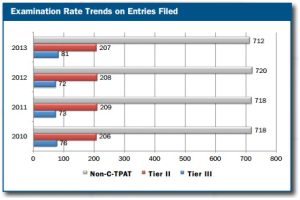
Welcome back! As promised, here is some information that you may find helpful when it comes to navigating the stormy waters of CBP exams.
As an international shipper, one of the most important steps you can take to avoid excessive delays and fees is to prepare every shipment as though customs will perform an inspection.
This means to always load your container in a way that allows the CBP officer(s) to quickly examine your cargo. If your cargo isn’t loaded neatly, CBP may take that as an indication that prohibited items are being hidden. To assist you, we’ve put together some container loading guidelines.
Some recommendations from CBP are to:
• Palletize your cargo
• Pack the container neatly so it doesn’t look like suspicious cargo is being hidden
• Leave enough room in the container for a drug-sniffing K-9 to access your cargo (down the center and at the top)
• Separate merchandise that is subject to different duty rates
• Ensure that all the goods are properly listed on the invoice
Another preventative measure is to become a C-TPAT partner. C-TPAT is a voluntary government-business initiative that builds cooperative relationships that strengthen and improve overall international supply chain and U.S. border security.

Photo courtesy of C-TPAT website
By becoming a C-TPAT partner, along with other benefits, you will experience less frequent exams (when compared to non-C-TPAT importers). Your tier level (I, II, or III) is taken into consideration by CBP’s internal risk assessment system and “C-TPAT partner companies are considered low risk and are, therefore, examined at a much lower rate than non-C-TPAT Partners,” as explained by CBP.
Lower risk equals fewer exams.
For more information on C-TPAT you can visit our Universal Cargo C-TPAT Validation Page or go directly to the C-TPAT website.
CBP explains that once the exam has started, CBP will make sure that the commercial invoice matches the cargo. “If the CBP officer finds any package that contains an article not specified on the invoice, and there is reason to believe the article was omitted from the invoice by fraud, gross negligence, negligence on the part of the seller, shipper, owner, or agent, a monetary penalty may be imposed, or in some cases, the merchandise may be seized or forfeited. (See e.g., 19 U.S.C. 1592.) “
To avoid additional delays and costs, make sure your container is loaded in a way that allows the CBP officer to perform an inspection.

Photo by James Tourtellotte for CBP
CBP has provided a Reasonable Care Checklist that importers can use to ensure they are in compliance with customs requirements. Please note that this list is not exhaustive, but rather a resource that can be used to assist importers with their efforts in compliance. Universal Cargo is a great partner to have when importing because with the combined experience of customs specialists, account managers, agents, and operations specialists, many of the items on the checklist will be covered. It’s up to the buyer and seller to make sure the cargo details are accurately documented (i.e., origin, value, quantity, etc).
Packing the container properly, getting certified and validated with C-TPAT, and complying with all US Customs and Border Patrol requirements will help to minimize any delays in receiving your cargo.
As inconvenient as these exams are, they are invaluable when it comes to public safety, national security and public health (to name a few). CBP isn’t just looking for importers undervaluing their cargo or using the wrong HTS code.
CBP is also stopping weapons, invasive pests and plants, and food that could cause severe illness or death from affecting the public. You may know (or think) that your cargo is safe, but it’s CBP’s responsibility to ensure the safety of 318,000,000 people in America.
That’s a big job.
Discover more from reviewer4you.com
Subscribe to get the latest posts to your email.





